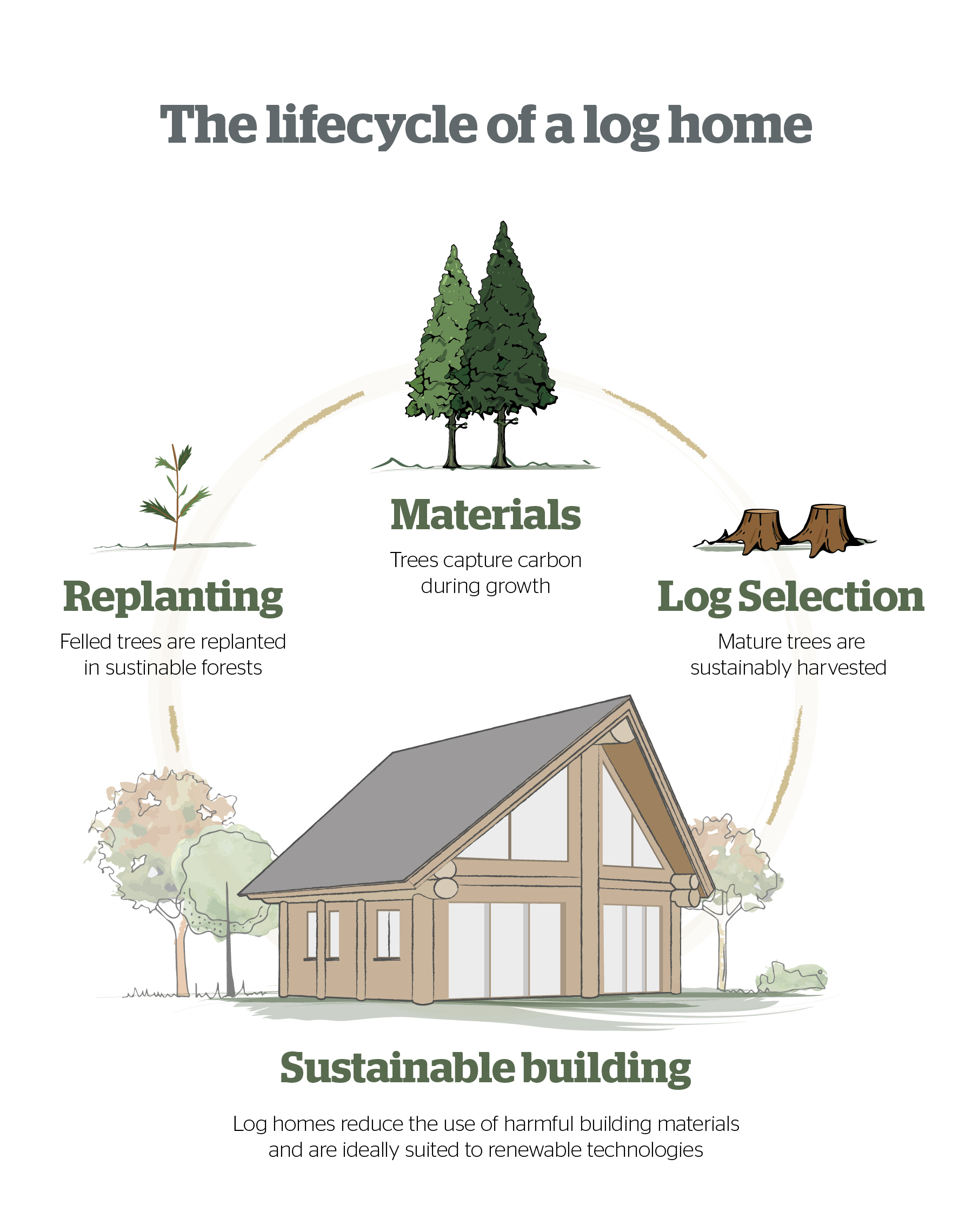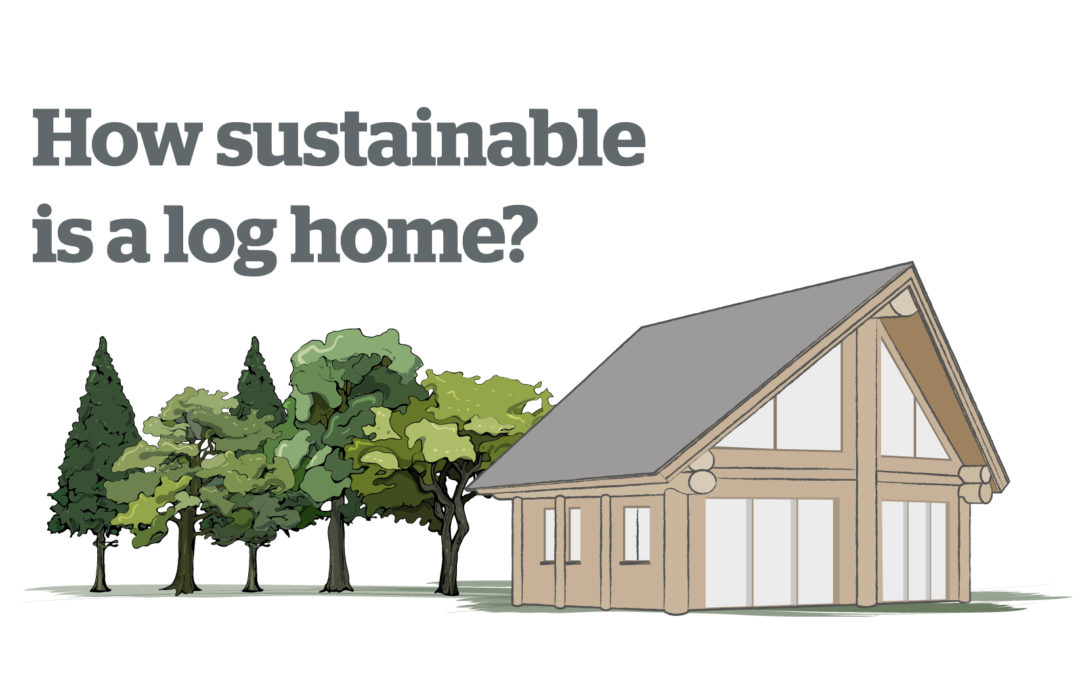Building with natural, local materials is one of the most sustainable forms of construction, but just how eco-friendly is a log home?
As far as the building industry is concerned, ‘carbon footprint’ is the term often used to describe the amount of CO2 the building produces during its operations and activities (either directly or indirectly). Greenhouse gas emissions caused by transportation and embodied carbon of the construction materials selected are a key contributor to the carbon footprint during the construction of a building.
The upfront carbon emissions associated with just three materials (concrete, steel, and aluminum) used in the construction of new buildings and infrastructure nearly equals annual building sector operational emissions.
Ed Mazria founder of Arch 2030
The carbon footprint of a building is often used to determine how eco-friendly or sustainable / resourceful a building is. So how does the carbon footprint of a log home compare to that of traditional buildings?
To assess the carbon footprint of a log home, it is important to look at the materials used in the building construction, how the building performs during its lifespan and what happens to it once it has reached the end of its intended usage.

The lifecycle of a log home
The carbon footprint of a log home is good indicator as to its eco-friendly or ‘green’ credentials. To complete the picture, it is important to look at the whole lifecycle of a log home, and not just how it operates once it is built.
1. Materials
As trees grow they absorb carbon dioxide from the atmosphere and emit oxygen, during a process called photosynthesis. As such, trees are an excellent source of carbon-capture. It is estimated that in Scotland, a single tree can remove as much as 1 tonne of CO2 from the atmosphere during its lifetime.1 In 2016 alone, around 12 million tonnes of CO2 was removed from the atmosphere by Scotland’s forests and woodlands.2
2. Log selection
In Scotland, Scottish Forestry has produced a set of standards and guidelines which ensures that our approach to forestry meets current demand and ensures sustainability for future generations.3 Forest and Land Scotland carefully mange our forests to ensure biodiversity, protecting a rich variety of wildlife and creating a landscape which looks great too. For every tree which is cut down, a greater number are replanted.
3. Sustainable building
Building with wood is a proven way to reduce greenhouse gas emissions, and the design of a log home ensures it has a low impact on the environment.
In a recent report by the Edinburgh Centre for Carbon Management (ECCM), it was estimated that harmful greenhouse gasses could be reduced by 88% through the use of log or timber structural elements in place of conventional building materials.3
The extraction and production of traditional building materials such as concrete and steel account for around 10% of total greenhouse gas emissions globally, and often need to be transported huge distances before they are used to create a building. By contrast, the timber used to create our eco-friendly log homes and log cabins is grown locally in Scotland, actively contributes to the capture of carbon and is a completely renewable resource.
As well as replacing the use of traditional materials in the fabric of the building, the structural design of a log home also contributes to it’s environmental credentials. A log home can be more energy efficient than a traditional building due to the low thermal conductivity of wood. Our log homes and log cabins can be insulated with natural energy efficient materials to increase their efficiency, reducing the costs of heating and cooling.
Finally, a new log home build presents a perfect opportunity to incorporate the use of renewable technologies such as solar panels, ground / air source heat pumps and natural green sedum roofing systems.
4. Replanting
As mentioned, Forest and Land Scotland are responsible for the careful management of our forests, ensuring more trees are planted annually than are felled. This is a key factor in the sustainable management of our timber stocks.
—
According to a report commissioned by the Scottish Building Standards Agency, and carried out by construction consultancy BRE, the average lifespan of a new build home in the Scotland is 60 years.4
A hand-crafted log home will last for generations and the timber used in its construction can be re-used, extending the process of carbon storage even further.
A log home is the ultimate in sustainable building, and a Caledonia Log Homes we hand-craft our log homes from local timbers grown throughout Scotland. We have also invested in our own in-house sawmill to ensure we can processing the timbers for our builds without the need for additional transportation. Combined with a passion for eco-friendly and renewable technologies we can craft a beautiful log home which will last for generations and won’t cost the earth.
For more information, please get in touch.
References:
1. www.forestryscotland.com/forestry/a-low-carbon-sector/low-carbon-facts–figures
2. www.gov.scot/publications/scotlands-forestry-strategy-20192029/pages/4/
3. www.forestry.gov.scot/sustainable-forestry/ukfs-scotland
4. www.forestry.gov.scot/images/corporate/pdf/carbon-benefits-of-timber-in-construction-2006.pdf
5. www2.gov.scot/resource/doc/217736/0091011.pdf

